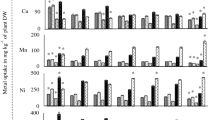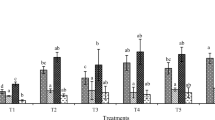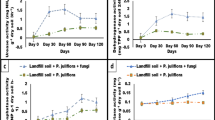Abstract
In this study, a pot experiment was piloted in a greenhouse to evaluate the potential of Celosia argentea var. cristata L. for tolerating/accumulating heavy metals in synthetic wastewater in the presence of Pseudomonas japonica and organic amendment, i.e., moss and compost. Two-week-old seedlings were transferred to pots, and after 4 weeks, the bacterial strain was inoculated, then watered with synthetic wastewater for 5 weeks and harvested after 9 weeks. After harvesting, physiological and biochemical parameters, as well as metal contents of plants, were quantified. The results indicated highest growth and biomass production in moss- and compost-associated plants while highest metal uptake has been found in the presence of P. japonica and synthetic wastewater–irrigated plants. Synthetic wastewater–irrigated plants have shown highest Pb uptake of 2899 mg kg−1 DW, while with P. japonica in soil those plants have shown highest Cd, Cu, Ni, and Cr uptake of 962, 1479, 1042, and 956 mg kg−1 DW, respectively. The production of antioxidant enzymes, i.e., catalase (CAT), ascorbate peroxidase (APX), guaiacol peroxidase (GPX), and glutathione-s-transferase (GST), was high in P. japonica–amended plants because of increased uptake of metals. It is concluded that moss and compost have improved growth while P. japonica improved metal accumulation and translocation to aerial parts with little involvement in plant growth.



Similar content being viewed by others
References
Adeleke R, Nwangburuka C, Oboirien B (2017) Origins, roles, and the fate of organic acids in soils: a review. S Afr J Bot 108:393–406
Arnon DI (1949) Copper enzymes in isolated chloroplasts. Polyphenoloxidase in Beta vulgaris. Plant Physiol 24:1–15
Arshad M, Khan AH, Hussain I, Anees M, Iqbal M, Soja G, Linde C, Yousaf S (2017) The reduction of chromium (VI) phytotoxicity and phytoavailability to wheat (Triticum aestivum L.) using biochar and bacteria. Appl Soil Ecol 114:90–98
Bao T, Sun T, Sun L (2011) Low molecular weight organic acids in root exudates and cadmium accumulation in cadmium hyperaccumulator Solanum nigrum L. and non hyperaccumulator Solanum lycopersicum L. Afr J Biotechnol 10:17180–17185
Boechat CL, Giovanella P, Amorim MB, de Sá ELS, de Oliveira Camargo FA (2017) Metal-resistant rhizobacteria isolates improve Mucuna deeringiana phytoextraction capacity in multi-metal contaminated soils from a gold mining area. Environ Sci Pollut Res 24:3063–3073
Bücker-Neto L, Paiva ALS, Machado RD, Arenhart RA, Margis-Pinheiro M (2017) Interactions between plant hormones and heavy metals responses. Genet Mol Biol 40:373–386
Chaudhary K, Agarwal S, Khan S (2018) Role of phytochelatins (PCs), metallothioneins (MTs), and heavy metal ATPase (HMA) genes in heavy metal tolerance. In: Mycoremediation and Environmental Sustainability. Springer, pp 39–60
Chen G-X, Asada K (1989) Ascorbate peroxidase in tea leaves: occurrence of two isozymes and the differences in their enzymatic and molecular properties. Plant Cell Physiol 30:987–998
Davenport SB, Gallego SM, Benavides MP, Tomaro ML (2003) Behaviour of antioxidant defense system in the adaptive response to salt stress in Helianthus annuus L. cells. Plant Growth Regul 40:81–88
Ding W, Clode PL, Lambers H (2019) Effects of pH and bicarbonate on the nutrient status and growth of three Lupinus species. Plant Soil:1–20
Dixit V, Pandey V, Shyam R (2001) Differential antioxidative responses to cadmium in roots and leaves of pea (Pisum sativum L. cv. Azad). J Exp Bot 52:1101–1109
Dzantor EK (2007) Phytoremediation: the state of rhizosphere ‘engineering’ for accelerated rhizodegradation of xenobiotic contaminants. J Chem Technol Biotechnol 82:228–232
Estefan G, Sommer R, Ryan J (2013) Methods of soil, plant, and water analysis. A manual for the West Asia and North Africa Region. 89:170–176
González-Valdez E, Alarcón A, Ferrera-Cerrato R, Vega-Carrillo HR, Maldonado-Vega M, Salas-Luévano MÁ (2016) Seed germination and seedling growth of five plant species for assessing potential strategies to stabilizing or recovering metals from mine tailings. Water Air Soil Pollut 227:1–10
Gupta P, Rani R, Chandra A, Kumar V (2018) Potential applications of Pseudomonas sp.(strain CPSB21) to ameliorate Cr6+ stress and phytoremediation of tannery effluent contaminated agricultural soils. Sci Rep 8:4860
Hadi F, Bano A, Fuller MP (2010) The improved phytoextraction of lead (Pb) and the growth of maize (Zea mays L.): the role of plant growth regulators (GA3 and IAA) and EDTA alone and in combinations. Chemosphere 80:457–462
Hojati M, Modarres-Sanavy SAM, Enferadi ST, Majdi M, Ghanati F, Farzadfar S, Pazoki A (2017) Cadmium and copper induced changes in growth, oxidative metabolism, and terpenoids of Tanacetum parthenium. Environ Sci Pollut Res 24:12261–12272
Jaskulak M, Rorat A, Grobelak A, Chaabene Z, Kacprzak M, Vandenbulcke F (2019) Bioaccumulation, antioxidative response, and metallothionein expression in Lupinus luteus L. exposed to heavy metals and silver nanoparticles. Environ Sci Pollut Res 16:1–13
Kalsotra T, Khullar S, Agnihotri R, Reddy MS (2018) Metal induction of two metallothionein genes in the ectomycorrhizal fungus Suillus himalayensis and their role in metal tolerance. Microbiology 164:868–876
Khan MIR, Nazir F, Asgher M, Per TS, Khan NA (2015a) Selenium and sulfur influence ethylene formation and alleviate cadmium-induced oxidative stress by improving proline and glutathione production in wheat. J Plant Physiol 173:9–18
Khan AR, Ullah I, Khan AL, Park GS, Waqas M, Hong SJ, Jung BK, Kwak Y, Lee IJ, Shin JH (2015b) Improvement in phytoremediation potential of Solanum nigrum under cadmium contamination through endophytic-assisted Serratia sp. RSC-14 inoculation. Environ Sci Pollut Res 22:14032–14042
Khan AHA, Tanveer S, Anees M, Muhammad YS, Iqbal M, Yousaf S (2016a) Role of nutrients and illuminance in predicting the fate of fungal mediated petroleum hydrocarbon degradation and biomass production. J Environ Manag 176:54–60
Khan AHA, Anees M, Arshad M, Muhammad YS, Iqbal M, Yousaf S (2016b) Effects of illuminance and nutrients on bacterial photo-physiology of hydrocarbon degradation. Sci Total Environ 557:705–711
Khan AHA, Butt TA, Mirza CR, Yousaf S, Nawaz I, Iqbal M (2019) Combined application of selected heavy metals and EDTA reduced the growth of Petunia hybrida L. Sci Rep 9:4138
Koptsik G (2014) Problems and prospects concerning the phytoremediation of heavy metal polluted soils: a review. Eurasian Soil Sci 47:923–939
Lajayer BA, Moghadam NK, Maghsoodi MR, Ghorbanpour M, Kariman K (2019) Phytoextraction of heavy metals from contaminated soil, water, and atmosphere using ornamental plants: mechanisms and efficiency improvement strategies. Environ Sci Pollut Res 26:1–17
Lichtenthaler HK (1987) Chlorophylls and carotenoids: pigments of photosynthetic biomembranes. Methods Enzymol 148:350–382
Liu J, Shi X, Qian M, Zheng L, Lian C, Xia Y, Shen Z (2015) Copper-induced hydrogen peroxide upregulation of a metallothionein gene, OsMT2c, from Oryza sativa L. confers copper tolerance in Arabidopsis thaliana. J Hazard Mater 294:99–108
Liu J, Xin X, Zhou Q (2017) Phytoremediation of contaminated soils using ornamental plants. Environ Rev 26:43–54
Maehly A, Chance B (1954) Methods of biochemical analysis by Glick D. Interscience, New York
Man YB, Chung AKC, Wong MH (2016) Changes in low molecular weight organic acids and antioxidative enzyme activities of wetland plants under metal stresses. Environ Eng Manag J 15:1657–1663
Marzilli M, Di Santo P, Palumbo G, Maiuro L, Paura B, Tognetti R, Cocozza C (2018) Cd, and Cu accumulation, translocation and tolerance in Populus alba clone (Villafranca) in autotrophic in vitro screening. Environ Sci Pollut Res 25:10058–10068
Michael PI, Krishnaswamy M (2011) The effect of zinc stress combined with high irradiance stress on membrane damage and antioxidative response in bean seedlings. Environ Exp Bot 74:171–177
Mishra R, Datta SP, Annapurna K, Meena MC, Dwivedi BS, Golui D, Bandyopadhyay K (2019) Enhancing the effectiveness of zinc, cadmium, and lead phytoextraction in polluted soils by using amendments and microorganisms. Environ Sci Pollut Res 26:1–12
Nadeem SM, Imran M, Naveed M, Khan MY, Ahmad M, Zahir ZA, Crowley DE (2017) Synergistic use of biochar, compost and plant growth-promoting rhizobacteria for enhancing cucumber growth under water deficit conditions. J Sci Food Agric 97:5139–5145
Singh RP, Jha PN (2018) Priming with ACC-utilizing bacterium attenuated copper toxicity, improved oxidative stress tolerance, and increased phytoextraction capacity in wheat. Environ Sci Pollut Res 25:33755–33767
Stancheva I, Geneva M, Hristozkova M, Markovska Y, Salamon I (2010) Antioxidant capacity of sage grown on heavy metal-polluted soil. Russ J Plant Physiol 57:799–805
Stanislawska-Glubiak E, Korzeniowska J, Kocon A (2015) Effect of peat on the accumulation and translocation of heavy metals by maize grown in contaminated soils. Environ Sci Pollut Res 22:4706–4714
Sytar O, Kumari P, Yadav S, Brestic M, Rastogi A (2018) Phytohormone priming: a regulator for heavy metal stress in plants. J Plant Growth Regul 38:739–752
Tandon S, Kumar R, Parsana S (2015) Auxin treatment of wetland and non-wetland plant species to enhance their phytoremediation efficiency to treat municipal wastewater. J Sci Ind Res 74:702–707
Upadhyaya A, Sankhla D, Davis TD, Sankhla N, Smith B (1985) Effect of paclobutrazol on the activities of some enzymes of activated oxygen metabolism and lipid peroxidation in senescing soybean leaves. J Plant Physiol 121:453–461
Venkatachalam P, Priyanka N, Manikandan K, Ganeshbabu I, Indiraarulselvi P, Geetha N, Muralikrishna K, Bhattacharya RC, Tiwari M, Sharma N, Sahi SV (2017) Enhanced plant growth promoting the role of phycomolecules coated zinc oxide nanoparticles with P supplementation in cotton (Gossypium hirsutum L.). Plant Physiol Biochem 110:118–127
Wang S, Zhao Y, Guo J, Liu Y (2018) Antioxidative response in leaves and allelochemical changes in root exudates of Ricinus communis under Cu, Zn, and Cd stress. Environ Sci Pollut Res 25:32747–32755
Xu P, Han N, Kang T, Zhan S, Lee KS, Jin BR, Li J, Wan H (2016) SeGSTo, a novel glutathione S-transferase from the beet armyworm (Spodoptera exigua), involved in detoxification and oxidative stress. Cell Stress Chaperones 21:805–816
Xu X, Yang B, Qin G, Wang H, Zhu Y, Zhang K, Yang H (2019) Growth, accumulation, and antioxidative responses of two Salix genotypes exposed to cadmium and lead in hydroponic culture. Environ Sci Pollut Res 26:19770–19784
Yahmed JB, de Oliveira TM, Novillo P, Quinones A, Forner MA, Salvador A, Froelicher Y, Mimoun MB, Talon M, Ollitrault P, Morillon R (2016) A simple, fast and inexpensive method to assess salt stress tolerance of aerial plant part: Investigations in the mandarin group. J Plant Physiol 190:36–43
Yang Z, Chen J, Dou R, Gao X, Mao C, Wang L (2015) Assessment of the phytotoxicity of metal oxide nanoparticles on two crop plants, maize (Zea mays L.) and rice (Oryza sativa L.). Int J Environ Res Public Health 12:15100–15109
Yang Z, Liu L, Lv Y, Cheng Z, Xu X, Xian J, Zhu X, Yang Y (2018) Metal availability, soil nutrient, and enzyme activity in response to the application of organic amendments in Cd-contaminated soil. Environ Sci Pollut Res 25:2425–2435
Zhang X, Li M, Yang H, Li X, Cui Z (2018) Physiological responses of Suaeda glauca and Arabidopsis thaliana in phytoremediation of heavy metals. J Environ Manag 223:132–139
Zhong L, Lin L, Liao M, Wang J, Tang Y, Sun G, Liang D, Xia H, Wang X, Zhang H, Ren W (2019) Phytoremediation potential of Pterocypsela laciniata as a cadmium hyperaccumulator. Environ Sci Pollut Res 26:13311–13319
Author information
Authors and Affiliations
Corresponding author
Ethics declarations
Conflict of interest
The authors declare that they have no conflict of interest.
Additional information
Responsible editor: Elena Maestri
Publisher’s note
Springer Nature remains neutral with regard to jurisdictional claims in published maps and institutional affiliations.
Electronic supplementary material
ESM 1
(DOCX 28 kb)
Rights and permissions
About this article
Cite this article
Iqbal, A., Mushtaq, M.U., Khan, A.H.A. et al. Influence of Pseudomonas japonica and organic amendments on the growth and metal tolerance of Celosia argentea L.. Environ Sci Pollut Res 27, 24671–24685 (2020). https://doi.org/10.1007/s11356-019-06181-z
Received:
Accepted:
Published:
Issue Date:
DOI: https://doi.org/10.1007/s11356-019-06181-z




